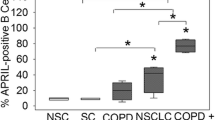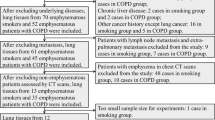Summary
This study explored the role of apoptosis of alveolar wall cells of chronic obstructive pulmonary disease (COPD) patients with pulmonary emphysema in the pathogenesis of emphysema. The subjects were divided into three groups: COPD patients with pulmonary emphysema (COPD group), asymptomatic smokers and non-smokers. Lung tissues were harvested and histologically assessed. TUNEL assay was employed to determine the apoptotic cells. The expression of PCNA, Bax and SP-C in the lung alveolar wall cells were immunohistochemically determined. SP-C immunofluorescence staining was used to identify type II alveolar cells in the TUNEL-positive cells. The mean linear interval (MLI), mean alveoli number (MAN) and mean alveoli area (MAA) in COPD group were significantly different as compared with those in asymptomatic smokers and non-smokers, respectively (P<0.01). The proliferation index (PI), apoptosis index (AI) and the percentage of Bax-positive cells in COPD group were significantly greater than those of asymptomatic smokers and non-smokers (P<0.01). However, the percentage of SP-C-positive cells was significantly lower in COPD group than in asymptomatic smokers and non-smokers (P<0.01). Most of the TUNEL-positive cells expressed SP-C. In COPD group, the apoptosis of alveolar wall cells, especially apoptosis of type-II cells, may take part in the pathogenesis of emphysema. Up-regulation of Bax expression may be responsible for the apoptosis of alveolar wall cells in the COPD patients with pulmonary emphysema.
Similar content being viewed by others
References
Barnes PJ, Shapiro SD, Pauwels RA. Chronic obstructive pulmonary disease: molecular and cellular mechanisms. Eur Respir J, 2003, 22(4):672–688
Kasahara Y, Tuder RM, Cool CD, et al. Endothelial cell death and decreased expression of vascular endothelial growth factor and vascular endothelial growth factor receptor 2 in emphysema. Am J Respir Crit Care Med, 2001, 163(3 Pt 1):737–744
Kasahara Y, Tuder RM, Taraseviciene-Stewart L, et al. Inhibition of VEGF receptors causes lung cell apoptosis and emphysema. J Clin Invest, 2000, 106(11):1311–1319
Shapiro SD. Vascular atrophy and VEGFR-2 signaling: old theories of pulmonary emphysema meet new data. J Clin Invest, 2000, 106(11):1309–1310
Aoshiba K, Yokohori N, Nagai A. Alveolar wall apoptosis induces lung destruction and emphysematous changes. Am J Respir Cell Mol Biol, 2003, 28(5):555–562
Tuder RM, McGrath S, Neptune E. The pathobiological mechanisms of emphysema models: what do they have in common? Pulm Pharmacol Ther, 2003, 16(2):67–78.
Tuder RM, Yoshida T, Arap W, et al. State of the art: cellular and molecular mechanisms of alveolar destruction in emphysema: an evolutionary perspective. Proc Am Thorac Soc, 2006, 3(6):503–510
Rahman I, Kilty I. Antioxidant therapeutic targets in COPD. Curr Drug Targets, 2006, 7(6):707–720
Yang SR, Chida AS, Bauter MR, et al. Cigarette smoke induces proinflammatory cytokine release by activation of NF-kappaB and posttranslational modifications of histone deacetylase in macrophages. Am J Physiol Lung Cell Mol Physiol, 2006, 291:L46–L57
Stoller JK, Aboussouan LS. Alpha1-antitrypsin deficiency. Lancet, 2005, 365(9478):2225–2236
Papaioannou AI, Kostikas K, Kollia P, et al. Clinical implications for vascular endothelial growth factor in the lung: friend or foe? Respir Res, 2006, 7:128
Segura-Valdez L, Pardo A, Gaxiola M, et al. Upregulation of gelatinases A and B, collagenases 1 and 2, and ncreased parenchymal cell death in COPD. Chest, 2000, 117(3): 684–694
Imai K, Mercer BA, Schulman LL, et al. Correlation of lung surface area to apoptosis and proliferation in human emphysema. Eur Respir J, 2005, 25(2):250–258
Yokohori N, Aoshiba K, Nagai A. Increased levels of cell death and proliferation in alveolar wall cells in patients with pulmonary emphysema. Chest, 2004, 125(22):626–632
Hodge S, Hodge G, Holmes M, et al. Increased airway epithelial and T-cell apoptosis in COPD remains despite smoking cessation. Eur Respir J, 2005, 25(3):447–454
Kasahara Y, Tuder RM, Cool CD, et al. Endothelial cell death and decreased expression of vascular endothelial growth factor and vascular endothelial growth factor receptor 2 in emphysema. Am J Respir Crit Care Med, 2001, 163(3 Pt 1):737–744
Kanazawa H, Yoshikawa J. Elevated oxidative stress and reciprocal reduction of vascular endothelial growth factor levels with severity of COPD. Chest, 2005, 128(5): 3191–3197
Aoshiba K, Yokohori N, Nagai A. Alveolar wall apoptosis causes lung destruction and emphysematous changes. Am J Respir Cell Mol Biol, 2003, 28(5):555–562
Petrache I, Natarajan V, Zhen L, et al. Ceramide upregulation causes pulmonary cell apoptosis and emphysema-like disease in mice. Nat Med, 2005, 11(5):491–498.
Tang K, Rossiter HB, Wagner PD, et al. Lung-targeted VEGF inactivation leads to an emphysema phenotype in mice. J Appl Physiol, 2004, 97(4):1559–1566
Imai K, Mercer BA, Schulman LL, et al. Correlation of lung surface area to apoptosis and proliferation in human emphysema. Eur Respir J, 2005, 25(2):250–258
Suzuki T, Moraes TJ, Vachon E, et al. proteinase-activated receptor-1 mediates elastase-induced apoptosis of human lung epithelial cells. Am J Respir Cell Mol Biol, 2005, 33(3):231–247
Hedy HG, Patrick TS, Tomoko S, et al. Leukocyte elastase induces epithelial apoptosis: role of mitochondial permeability changes and Akt. Am J Physiol Gastrointest Liver Physiol, 2004, 287(1):286–298
Nakajoh M, Fukushima T, Suzuki T, et al. Retinoic acid inhibits elastase-induced injury in human lung epithelial cell lines. Am J Respir Cell Mol Biol, 2003, 28(3):296–304
Clark H, Reid K. The potential of recombinant surfactant protein D therapy to reduce inflammation in neonatal chronic lung disease, cystic fibrosis, and emphysema. Arch Dis Child, 2003, 88(11):981–984
Author information
Authors and Affiliations
Additional information
This project was supported by a program of medical research of Henan Province (No. 200902012).
Rights and permissions
About this article
Cite this article
Liu, H., Ma, L., Wu, J. et al. Apoptosis of alveolar wall cells in chronic obstructive pulmonary disease patients with pulmonary emphysema is involved in emphysematous changes. J. Huazhong Univ. Sci. Technol. [Med. Sci.] 29, 466–469 (2009). https://doi.org/10.1007/s11596-009-0415-7
Received:
Published:
Issue Date:
DOI: https://doi.org/10.1007/s11596-009-0415-7




